
Traveling Through History
Issue 36 - Prague, Czech Republic - Part 1
This week we are in Prague, the capital of the Czech Republic.
It was the first time there for us and it was utterly delightful.
A beautiful ancient city that has a varied history.
If you’ve ever watched any programs that talk about or are set in Bohemia, then this is usually where they go (Discovery of Witches I am looking at you!).
Although we had three nights in Prague, it didn’t seem like enough time and we would gladly go back again, for a bit longer.
I hope you enjoy Traveling Through Bohemian History with me this week.
Michelle
Savvy Travel Historian

The capital of Czechia (the Czech Republic), Prague was the historic capital of Bohemia and is located on the Vltava River.
Several Holy Roman Emperors (including Charles IV and Rudolf II) made it their home and its importance to the Habsburg monarchy and Austro-Hungarian Empire can not be understated.
Located an easy four hour drive south from Berlin, two hours from Dresden and three hours west of Nuremberg, it has close ties to its German neighbours.

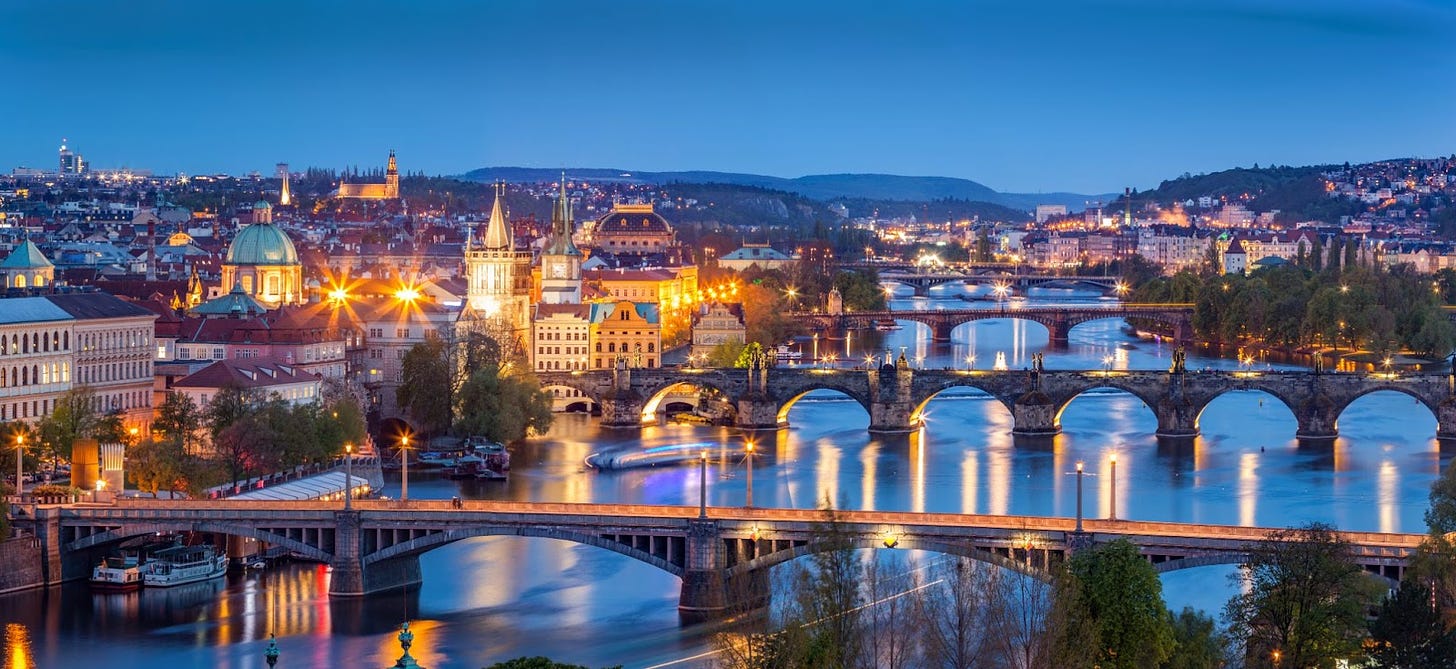
Praha, the Czech name for Prague, derives from an old Slavic word meaning ‘ford’ or ‘rapid’, referring to it being a crossing point on the Vltava River. The English spelling is derived from Latin.
A settlement was established in the region from the Palaeolithic age and around the fourth and fifth century BC a Celtic tribe in the area developed a large Iron Age settlement in what became Bohemia.
The Celts were driven out by Germanic tribes in the last century BC, and when the fall of the Western Roman Empire in the 5thC caused a period of huge migration on the Continent, Slavic tribes moved into Bohemia after the Germanics moved further westward.
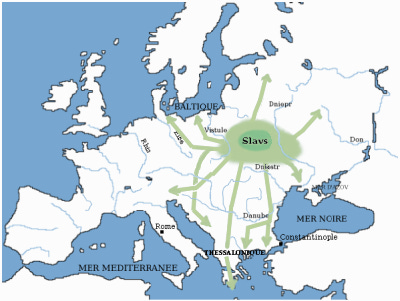
Construction on what was to become Prague Castle (featured in next week’s issue) began towards the end of the 9thC and the fortified settlement has existed for over 800 years.

The region became the seat of the dukes and later the kings of Bohemia and was an important trading town that attracted merchants from across Europe who settled there, including many Jews.
It was not until around 1257 that the opposite side of the river was developed (around Prague Castle) into an area known as the ‘Lesser Quarter’.

During the 14thC Prague flourished due mainly to the reign of Charles IV, Holy Roman Emperor and King of Bohemia. He was to transform Prague into an imperial city.
Charles was to build the Charles Bridge (discussed later in this issue), which connected the city with the east bank districts and ordered the building of the ‘new town’ which was to be adjacent to the ‘old town’ and even developed the design himself.
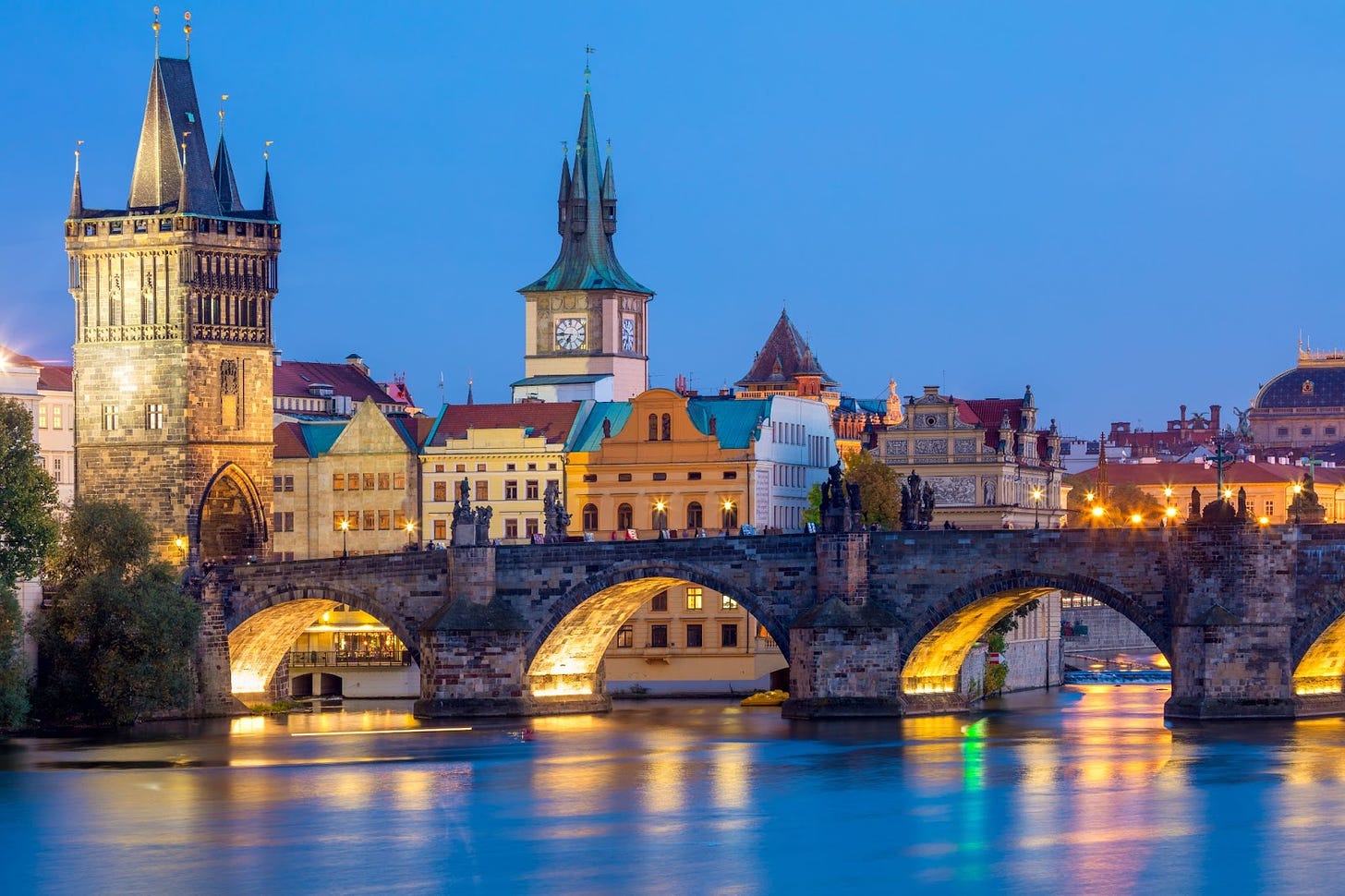
When Charles died in 1378, his son King Wenceslaus IV ascended the throne, and turmoil ensued. It was said that during Easter 1389, some Jews had desecrated the host during communion and urged on by the clergy, people ransacked, pillaged and burnt the Jewish quarter of the city, murdering almost all 3,000 Jews in the process.
Ferdinand I of the House of Habsburg was elected by the Bohemian Estates in 1526, but his Catholic views clashed with the Protestant ideas that were gaining popularity in Prague.
The city prospered under Holy Roman Emperor Rudolf II who was King from 1576. He was an art lover and welcomed not only artists but scientists, musicians, astrologers and magicians to his court in Prague Castle where he lived. This made Prague the capital of European culture during this period.
In 1618 the ‘Defenestration of Prague’ was a result of disgruntled protestants throwing out the window of Hradčany Castle, two royal governors and their secretary (see painting below - amusingly in the National Gallery of Victoria, where we used to live!).
This ultimately provoked the period known as the Thirty Years’ War.
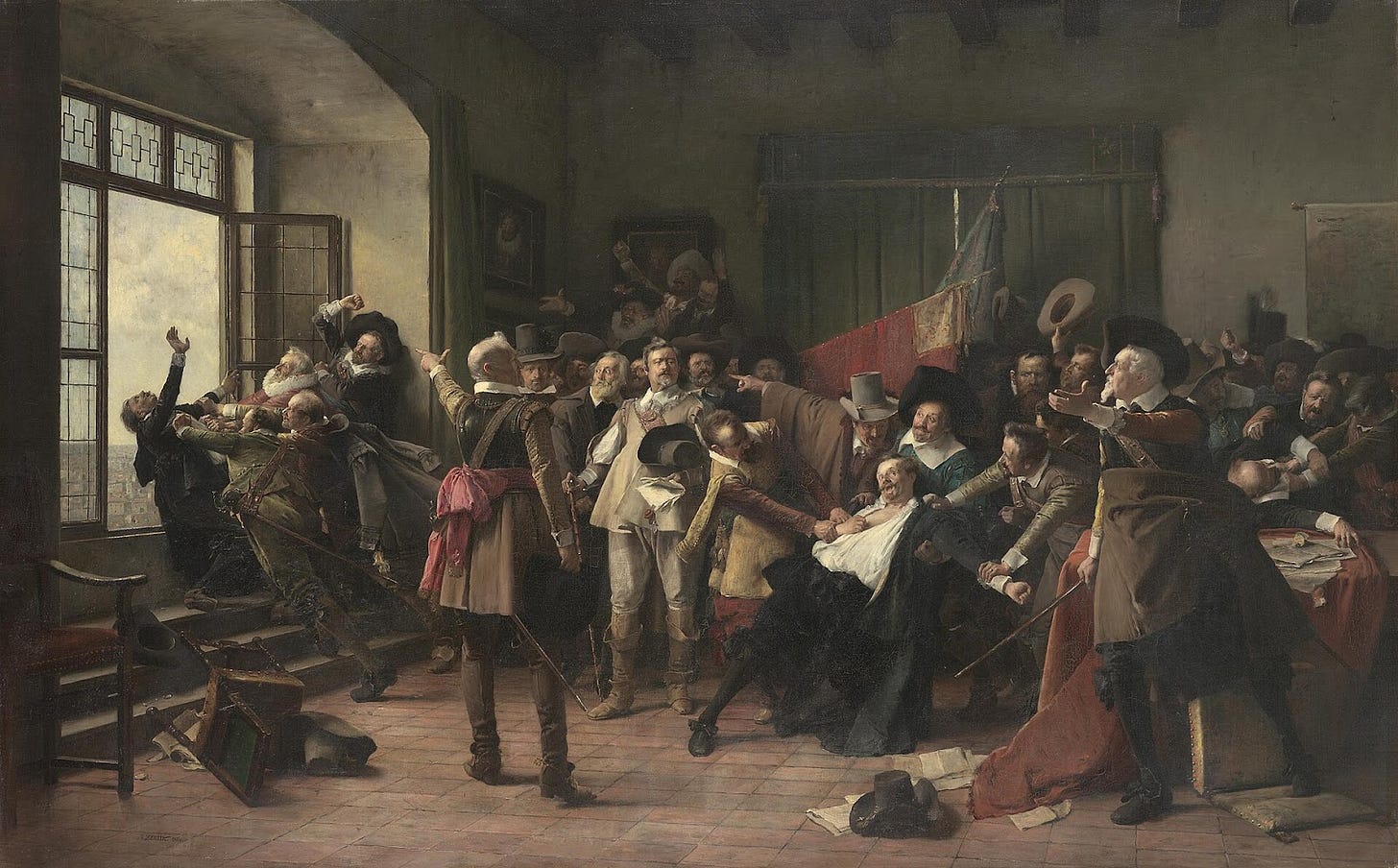
In 1744, Frederick the Great of Prussia invaded Bohemia and he took control of the (near destroyed) town after a prolonged and severe siege.
The economy of Prague grew during the 18thC, so did its population; exceeding 100,000 by 1837.
During the 18th and 19thC there was a Czech National Revival movement that wanted to revive the Czech language, culture and national identity.
At the end of WWI Czechoslovakia was created and Prague chosen as its capital. By 1930 the population was 850,000.
Hitler ordered the invasion of Prague on March 15,1939 and he took over Prague Castle, deporting most of the Jews who lived there. The city was bombed by the US Army Air Forces in February 1945.
After the end of WWII, Prague was under the control of the Soviet Union, inside the Eastern Bloc. Demonstrations in 1967 against the regime were met with brutal force and the Red Army would occupy Czechoslovakia until 1991.
The Velvet Revolution in 1989 was a peaceful demonstration against the ‘one party’ rule they had been subjected to; it began what was to be a transition to the first democratic elections in 1990. The blockade with West Germany and Austria was dismantled in December 1989.
In 1992 the country was split into the Czech Republic and the Slovak Republic.

The Old Town of Prague dates back to the medieval period and was surrounded by a semi-circular moat and wall. The moat is now covered by the narrow streets that are largely for pedestrians and the district is called Prague 1.


The traditional hub of Prague and a tourist hotspot due to the World famous astronomical clock on the town hall, the outside of the square is lined with restaurants and it is where the traditional Christmas and Easter markets are held.

Town councillors purchased a house on this site in 1338 to allow them to undertake town business but over the centuries, this original building has almost disappeared due to extension and renovations.
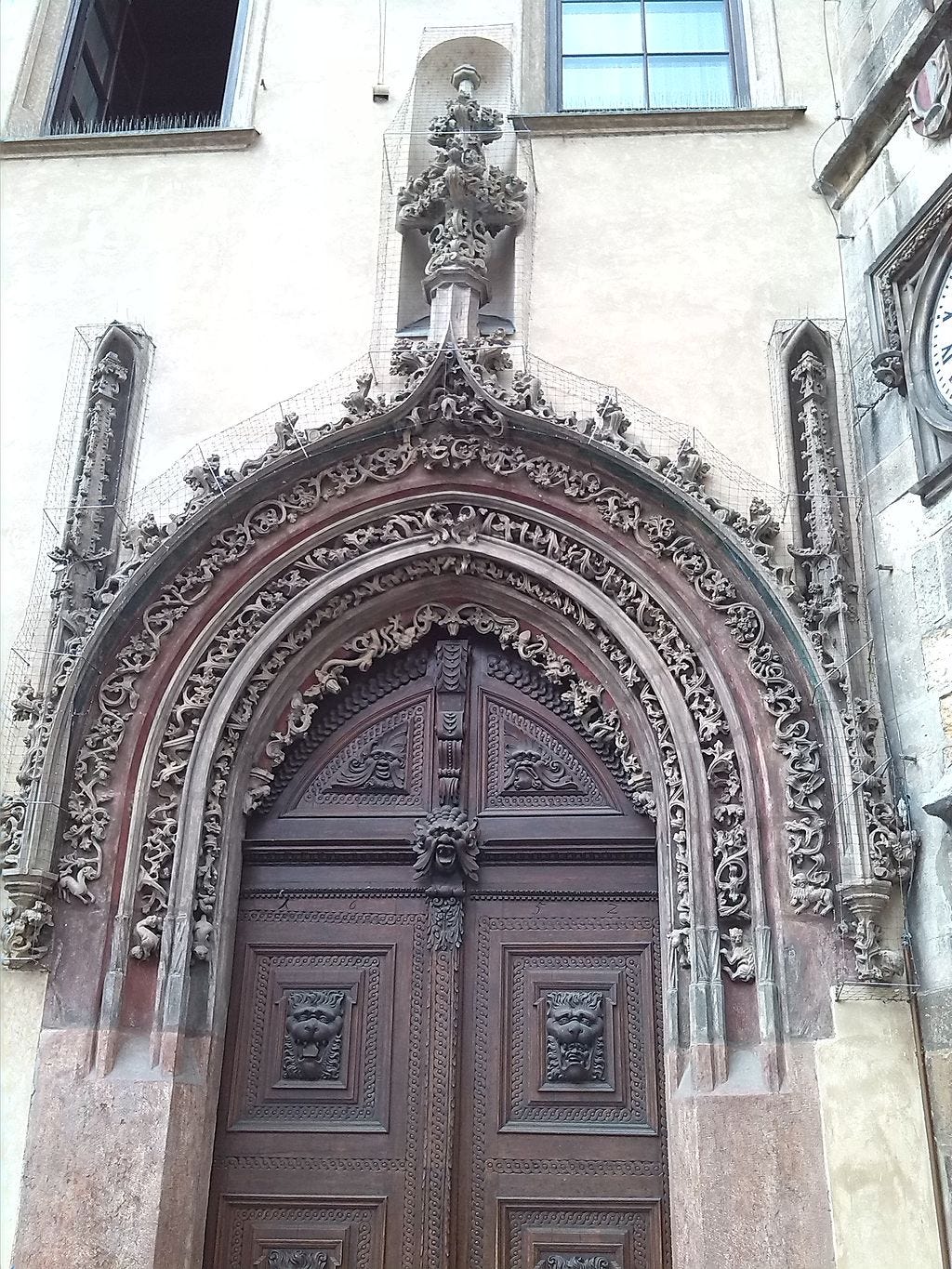
Only the original Gothic door to the west remains intact (shown above).

The property was expanded over the years by buying up adjacent buildings and presents as a collection of buildings all pieced together into one. The Town Hall Chapel portal (shown above), was consecrated in 1381 and is the only remaining piece of the original Chapel that perished in the May 1945 fires during WWII.
The emblems (built by the royal stonemason’ lodge) date from the reign of Wenceslas IV.

The main attraction in the Old Town Square is undoubtedly the Prague Orlo (astronomical clock).
It is on the southern Gothic tower wall of the Old Town Hall and was installed in 1410. It is the oldest such clock still in operation and the third-oldest astronomical clock in the world. Its mechanism was perfected by master craftsman Hanuš in the 15thC and was operational until 1865 when it stopped. Prague watchmaker Ludvik Hainz was able to repair it and he became the caretaker, a tradition which is carried through to the present day by his descendants.

It had three main components.
The top section is an astronomical dial, which represents the position of the sun and the moon and shows four different times.
Central European time, shown by the sun hands and Roman numerals on the perimetre.
Babylonian time - which is unequal because the hours last longer in the summer time than winter, and is measured from sunrise to sunset (a unique feature to this clock).
Star time - shown by the Roman numbers.
Calendar Dial - showing day, position within the week, a month and a year.
The clock used to show Old-Bohemian time (still displayed as the golden Gothic numbers on the ring outside the sphere).
The moveable black ring in the centre shows the signs of the zodiac.
The background represents the Earth and the local view in the sky. The centre circle, the Earth. The upper blue section is the portion above the horizon, likewise the red and black areas, below the horizon. During dawn or dusk the mechanical sun is positioned over the red section.

On the hour between 9am and 11pm, (after the skeleton pulls the rope to start it) the statues of the 12 Apostles appear at the two doorways of the clock and ‘walk’ past the now open doorway (window). Each of them carries an attribute associated with them.
St Peter has a key, St Matthew an axe, St John a chalice, St Andrew an X-shaped cross, St James a washboard and are all in the left window.
In the right window, St Paul with a book, St Thomas with a spear, St Simon a saw, St Thaddeus with boards, St Bartholomew leather and St Barnabas a scroll.
The fire in 1945 destroyed all the original figures but they were replaced in 1948.

The animated figures on either side of the clock represent the four frailties prevalent at the time; vanity (figure looking at himself in the mirror), greed (the miser holding a bag of gold), death - a skeleton) and lust & earthly pleasures shown as a Turkish figure on the far right.
The rooster in the very top window crows as the apostles' doors close and the tower bell starts to chime the hour.

The calendar section of the clock has four static figures named Philosopher, Astronomer, Chronicler and the Archangel Michael.
It shows a church calendar with fixed holidays listed, along with the names of 365 saints. Images of the months plus zodiac signs are in the circle.

The main church in the centre of Prague since the 14thC, the towers of the church are 80m high, with each tower having eight smaller spires in two layers (of four each layer).
It’s late Gothic style, has three internal aisles and maintains its original medieval furniture throughout.

St Nicholas Church (Staré Město), was built between 1732-1737 and is a late Gothic and Baroque church on the western end of Old Town Square.
During the Prague uprising in 1945, Radio Prague was hidden inside the building.

The monument depicts Hussite warriors and Protestants who were forced to exile 200 years after Hus. It was unveiled in 1915 to commemorate the 500th Anniversary of Hus’ martyrdom.
Jan Hus was an influential religious thinker, reformer and philosopher in Prague.
Inspired by the teachings of John Wycliffe, he believed that the mass should be celebrated in the vernacular and not Latin (like Luther and Tyndale after him) and was condemned at the Council of Constance and burned at the stake in 1415.
This led to the Hussite Wars between the Hussites and the Catholic Church from 1419 - 1434.
It has become a popular meeting point and is often at the centre of protests in the city.

Construction began on the medieval stone bridge in 1357 by King Charles IV and was finished in the 15thC.
The previous bridge crossing here (called the Judith Bridge) was badly damaged by floods in 1342.
The bridge is 516m long and almost 10m wide. Based on the stone bridge in Regensburg, it has 16 arches, which are shielded by ice guards.

A continuous alley of 30 statues and statuaries, mostly in a baroque style adorn the bridge , with some installed around 1700. The ones on the bridge today are replicas of the originals.
The statue above is relatively new (1938) and is of Saint Cyril and Methodius who are said to have brought Christianity to the Slaves and were the creators of the Slavic language.

The statue above depicts Saints Norbert of Xanten, Wenceslaus and Sigismund and was commissioned by the abbot of Strahov Monastery in 1853.

This sculpture is one of the more interesting historical pieces on the bridge.
Originally a wooden cross would have been installed here in 1361 but was destroyed in 1419. A new crucifix with a wooden corpus was erected in 1629 but was damaged during the Thirty Years’ War.
The metal cross was installed in 1657 and in 1666 the two figures of the Virgin Mary and John the Baptist were added to the sides.
The golden Hebrew text at the top was added in 1696

One of the largest sculptures on the bridge is this one of Saints, John of Matha, Felix of Valois and Ivan, designed in 1714. It is supposed to depict the rescue of Christians from the Turks. The cage at its base, has three chained Christians inside praying for salvation from the Lord.

The Bridge is protected by three towers, two on the ‘Lesser Quarter’ side and one on the Old Town Side. The tower above, on the Lesser Quarter side, is known as the Malá Strana Bridge Tower and is the entrance to one of the most historic districts in Prague.

At the Old Town end, is the third tower.

The Gothic tower was built in 1357.

For its 660th Anniversary, Google featured the Bridge as its Google Doodle that day.
https://doodles.google/doodle/660th-anniversary-of-charles-bridge/

Jewish settlers have been in Prague since the 10thC. The first pogrom was in 1096 during the first crusade and they were eventually concentrated in a walled Ghetto north of Old Town Square.
The Ceremonial Hall of the Prague Jewish Burial Society (image above) was constructed in 1906-08 in a Romanesque Revival style. A morgue was in the basement but it has not been used for this purpose since WWI. The Jewish Museum of Prague has rented the space since 1926.
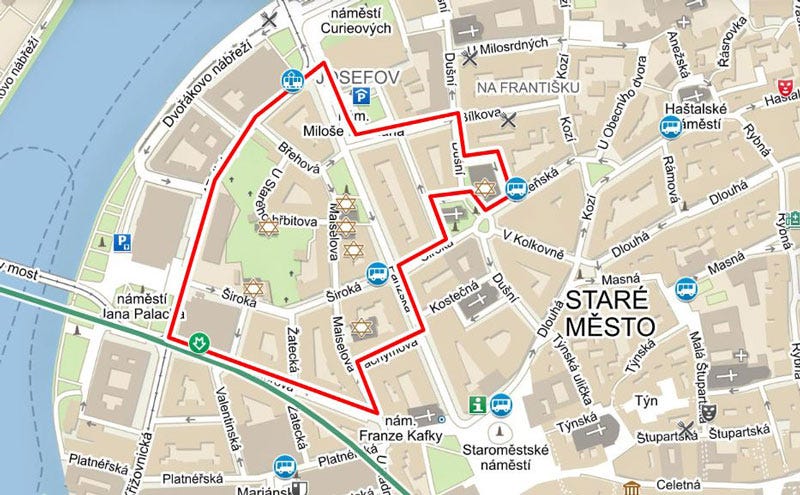
Most of the original buildings within the Jewish Quarter were demolished between 1893 and 1913 and the current ones were modelled on Paris, so it has a very Parisian ‘feel’.

Many expensive brands have store fronts there. Dolce and Gabbana, Rolex, Chanel and Prada, to name but a few.

During WWII the Nazi’s deported at least two-thirds of the 90,000 Jews living in Prague at the time. There is a belief, although many historians have yet to find evidence for it, that Hilter wanted to preserve the Jewish Quarter in Prague as a living museum of an extinct race.
When the Germans took over Prague and the Jewish Museum it only had 760 artifacts but after the war, more than 140,000 had been collected from synagogues in Central Europe and Czechoslovakia. There are many theories around this but regardless there is no written evidence in any of the Nazi records that this is what they intended.
The following article has an interesting discussion about this topic:

The Old New Synagogue (below) is Europe's oldest active medieval synagogue (750 years old). It follows the orthodox custom of separate seating for men and women during prayer services.

Located alongside is tourist information billboards on Josefov and a souvenir shop.
https://www.synagogue.cz/
The Old Jewish Cemetery was used from the early 15thC until 1786. The oldest gravestone is from 1439.

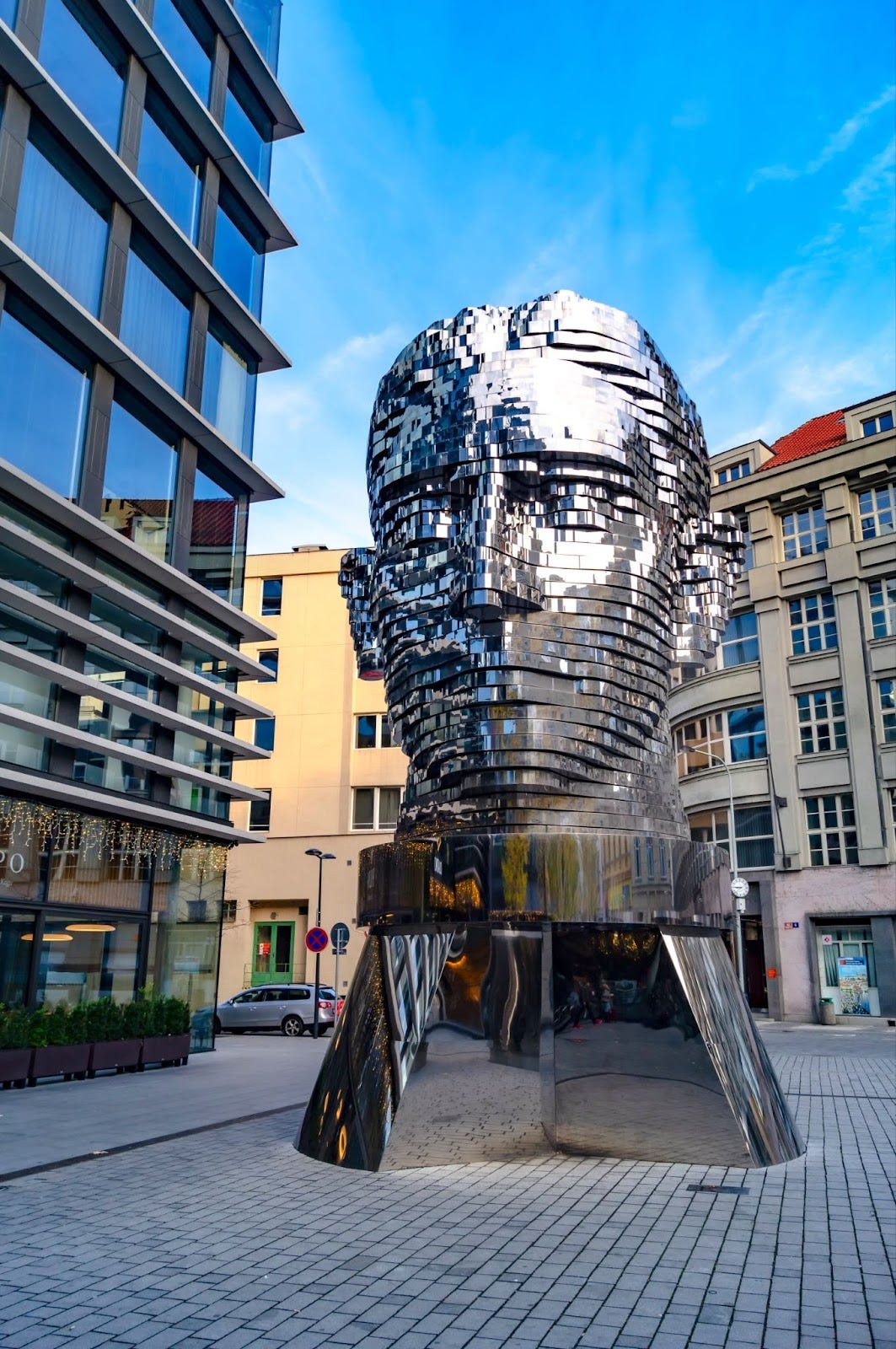
Regarded as one of the major 20thC literary figures, Franz Kafka was born near the Old Town Square in Prague in July 1883 to a Jewish family.
His most famous work The Metamorphosis (Die Verwandlung) is a novella about salesman Gregor Samsa who wakes up one morning to discover he’s been turned into a huge insect and his struggles to adjust to his new condition. In popular culture he is often depicted as a cockroach.

Kafka was not famous for his writing during his lifetime and only subsequently became famous after his friend Max Brod published his works, despite Kafak’s request in his will that they all be destroyed. In 1933 the Gestapo confiscated 20 notebooks and 35 letters of Kafka that scholars are still searching for. When Brod fled the Nazis in 1939, he took suitcases of Kafka’s works with him to Palestine.
A number of memorials to Kafka are around the city of Prague including this 11m tall, 39 ton head of Kafka (shown above) at the back of the Quadrio shopping centre (which was not far from our accommodation). Unveiled in 2014, the 42 layers designed to form Kafka’s face are mechanised and rotate individually.

Unfortunately it was covered up when we were there so we could not actually see the sculpture, but the above billboard in the shopping centre was a good way to let people know what was going on.
https://www.prague.eu/en/object/places/1886/statue-of-kafka
Kafka died in Vienna from tuberculosis on June 2, 1924 and is buried in the New Jewish Cemetery in Prague.
Traveling Through History is a reader-supported publication. To receive new posts and support my work, consider becoming a free or paid subscriber.

Located in the Lesser Town Quarter of Prague, the Museum opened in 2005 and has a number of first editions as well as incorporated exhibits and displays that show visitors the quirky side of Kafka’s writings.
Out the front of the museum in the courtyard, that also contains eateries and areas to sit down, is an exhibit called ‘Piss’, which displays two men urinating into a pond, in the shape of the Czech Republic. It was created by artist David Černý, who also did the head sculpture shown above.

From a recipe created over 200 years ago, these cinnamon donut type cone shaped bases can be eaten plain or filled with chocolate and fruits and then topped with soft serve ice cream and a selection of additional toppings to finish it off. The original recipe was owned by a Transylvanian cook!

They are called Trdelnicks (pronounced a little like ‘turtlenecks’) and our boys divide into one at 10pm at night (even after a big dinner!).
They are mostly available in Prague, so you’ll have to go there to try one.

Located in Old Town, U Medvídků restaurant has been serving food since 1466!
This medieval establishment has a restaurant, brewery and hotel in the same complex.

The traditional Czech food served is worth trying and we all enjoyed our evening there.

Located all over Old Town are sweet shops that have impressive looking displays of various shaped and brightly coloured meringue and marshmallow sweets.

Popular with tourists and locals alike!

Getting around Prague is easy with their tram (and train) system. They are frequent and go everywhere within the inner city for all the places you are likely to want to see.
Relevant Travel Information:
The official website for Prague is below:
Next Week we will be Traveling Through History by spending the whole day exploring Prague Castle, see you then.
Reminder:
From March 1st, there will be exclusive parts of my newsletter available to paid subscribers only each week. Until then, you can get a discount of 20% for an Annual Subscription or 10% on a Monthly one. Use the link below to upgrade to paid.

Michelle is a speaker, author, content marketer, historian and mother of 3 boys.
After 25 years in business and as the ‘Content Marketing Queen’ for the past 12 years, she has helped countless small businesses understand and develop their content strategies and focus on a customer first approach.
Savvy Travel Historian is her passion project, and her weekly newsletter is available on Substack, Paragraph and Mirror. The latter two allows you to collect each Issue as an NFT.
Michelle is co-host of the Business on the Bloc Podcast, a weekly show which talks about current stories in the Web3 space and how it applies to B2B marketing, sales and operations.
The show is recorded live every Wednesday at 4pm EST/ 9pm UTC on LinkedIn, YouTube & Bolt+.
You can follow Michelle in these places:
Savvy Travel Historian Instagram
